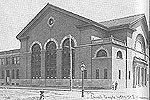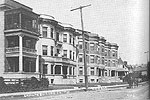
Grand Boulevard
— Washington Park (continued)
Because of its proximity to the center of the city. Grand Boulevard
developed at a faster rate than the Washington Park district.
The most desirable location for single-family homes was Grand
Boulevard itself, a beautifully landscaped thoroughfare which
extended from 18th Street to 51st Street, where it formed the
entrance to Washington Park. (South of 51st Street the avenue
was known as South Park; the street is now Dr. Martin Luther King,
Jr., Drive.) Wealthy Chicagoans, many of them sons and daughters
of immigrant entrepreneurs, built elegant houses along the boulevard,
while middle-class families purchased spacious brownstones on
side streets such as Forrestville, Champlain, and Langley West
of Grand Boulevard, two- and three-story apartments filled up
the long city blocks, especially Michigan, Indiana, and Prairie
Avenues.
The building boom of the 1890s transformed the prairies east
and west of Grand Boulevard into a city neighborhood. While most
of the pioneer settlers remained, the community expanded to include
second generation German Jews and Irish Catholics who had moved
up and out of congested areas on the South and Near West Sides
of the city. These families quickly put down roots and established
synagogues, churches, and charitable institutions. The history
of Temple Isaiah illustrates the speed with which a Jewish community
was formed in Grand Boulevard.
Temple Isaiah was established in
1895 by men and women who had formerly belonged to Zion Temple
at the corner of Washington Boulevard and Ogden Avenue on the
West Side (See Fig. 1). According to the Chicago Inter
Ocean, by
the early 1890s "practically the entire society of Zion
temple had settled in the neighborhood of Fortieth Street,
between Drexel
and Grand boulevards." The new Reform congregation worshiped
in Oakland Club Hall at 39th and Cottage Grove until the temple
at 4501 S. Vincennes Avenue was dedicated in 1899 Temple Isaiah
was an innovative congregation, admitting single and married
women
to membership, and its magnificent synagogue was the last major
work of architect Dankmar Adler.
The Jewish population of Grand Boulevard continued to
increase after the turn of the century, and by 1915 the neighborhood
included such important synagogues as
Sinai Temple (See Fig. 2). 46th and Grand Boulevard;
Beth Hamedrash Hagadol (Anshe Dorum), 5129 S. Indiana Avenue;
and B'nai Sholom Temple
Israel, 53rd and Michigan Avenue.
«
previous
3
of 14
next
»
|
 |

|
 |


Figure
1: Temple Isaiah, 4501 S. Vincennes Avenue, c. 1910. »

Figure
2: Brick flat buildings with bay windows and spacious porches
line the west side of Grand Boulevard (King Drive), just across
the street from Washington Park.»
|